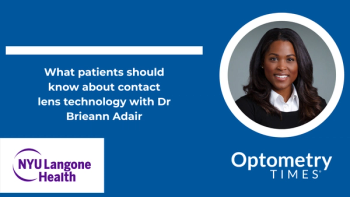
- September digital edition 2020
- Volume 12
- Issue 9
10 things your patients should know about COVID-19 and contact lenses
Contact lenses remains safe, but unwell patients may want to avoid them altogether
As information about the novel coronavirus continues to develop, patients are looking to ODs for reliable leadership on eye health maintenance. Currently, there is no evidence to suggest an increased risk of contracting COVID-19 through contact lens wear. However, safety measures like regular hand washing and case cleaning must be observed.
At this point in 2020, ODs have taken quite the roller coaster ride. Deciding when to re-open, what funding is available and how to access it, determining the exposure risk is at the office to staff and patients, how to stay safe, and what to expect financially in the months to come?
Several patients have contacted me to ask if it is safe to continue wearing contact lenses. This is something I pondered before answering. There was initially significant concern about the contractibility of COVID-19 through human tears. Contact lens wear is not completely risk free, though the risk is not what one would assume.
A close friend and colleague works for a large private equity group. This group initiated a mandatory measure that staff is not to wear contact lenses (unless there are extenuating circumstances). My question to her was whether or not patients were being directed in the same manner. The answer was a resounding, “Definitely not!” So, let’s get on the same page regarding the current risk and how to better educate our patients on staying safe.
Looking at studies
In 2003, case studies showed the SARS coronavirus to be detectable in tear samples using a polymerase chain reaction (PCR) technique.1 This raised a lot of concern when the ophthalmic world first became aware of the COVID-19 pandemic.
Xia et al tested 30 COVID-19 positive patients via tear samples and conjunctival scraping. One subject tested positive via conjunctival scrape while having an active conjunctivitis. Because the other patients were negative, the hypothesis was that the virus is found only on the ocular surface when there is active conjunctivitis. But the author notes that volume used for tear sample and conjunctival testing may be insufficient to detect the virus. Therefore, ODs should remain cautious in treating those without conjunctivitis carefully.2
Another study by Seah et al hypothesized that COVID-19 virus could potentially travel into the tear film by way of the nasolacrimal system. The study looked at 17 COVID-19 positive patients who had been admitted to the hospital. Upon admission, all were without ocular symptoms. While hospitalized, one patient developed chemosis and injection. Tear samples were collected during each of the first 3 weeks of the patient’s illness. There were 64 collective tear samples acquired. While the nasal and throat swabs showed viral load elevation for approximately 2 weeks, the tear samples were negative for viral isolation via RT-PCR technology in 100 percent of collections, regardless of disease severity or symptoms.3
Bostanci evaluated 93 hospitalized COVID-19 positive patients (54 male and 39 female aged 7 to 88 years with a mean age of 39.4 ± 21.9). Some 20 patients had at least 1 ocular abnormality including hyperemia (20), epiphora (9), increased secretion (6), chemosis (3), follicular conjunctivitis (2), and episcleritis (2), with 15 of the patients reporting photophobia as the most common symptom. Older age, high fever, increased neutrophil to lymphocyte ratio, and high levels of acute phase reactants (CRP, PCT, ESR) were determined to be risk factors for ocular involvement. Lymphocyte counts were lower in those with ocular manifestations, and 4 patients died. Of the 93 hospitalized patients, 21.5 percent had ocular abnormality.4
The current consensus is that the risk of COVID19 transmission via tears is minimal. Does this mean ODs are in the clear? Maybe not because contact lens wear is not completely without risk. Currently, the habits surrounding contact lens wear seem to be the biggest assumed risk.
Fortunately, we don’t have to worry about virusfilled tears being harbored by the contact lens. But we should be cognizant of the growing need for meticulous hygiene and habits during this season of high risk. The American Optometric Association,5 Centers for Disease Control,6 and various research institutions7 have provided useful practice guidelines, and here are pearls we can pass on to patients.
1
Currently, there is no convincing evidence of viral shedding of COVID-19 in the tears; therefore, there is low likelihood of viral transmission through tears.
2
Standard spectacle glasses do not provide protection from COVID-19. The tiny respiratory and oral particles can still find their way to an entry point.5
3
Contact lens wear itself does not increase risk for contracting COVID-19.5 However, if you are sick you should not wear your contact lenses.
4
Applying or removing lenses without washing your hands properly does increase your risk of contracting COVID-19 (as well as other infections). Be sure to wash your hands with soap and warm water for at least 20 seconds. That equates to 2 rounds of Happy Birthday or Old McDonald, though you may hesitate to belt it out in the exam room. Soap and water are preferred to a hand sanitizer because the alcohol in the sanitizer can cause ocular discomfort.
5
Touching your eyes and face does increase your risk for COVID-19. This is probably the most significant negative to consider and is especially important for contact lenses wearers to remind themselves throughout the day. This risk is controllable, if hand washing is observed.
6
The best way to resist touching your eyes is to ensure contact lenses are comfortable throughout the day. If rewetting drops improve comfort, use them. However, be adamant that you never instill a drop without washing hands thoroughly first.
7
Another way to improve comfort and limit eye touching throughout the day is to wear daily disposable lenses. Of course, this reduces contact lens handling and risk of contamination. However, reusable lenses themselves do not increase the risk for COVID-19.
8
According to the CDC, if you are using reusable lenses, you should clean them nightly with a hydrogen peroxide-based solution. While peroxide-based solutions are believed to be effective against COVID-19, this has not been validated with multipurpose solutions.7 Never allow lenses to come into contact with water.
9
Again, the goal is to maximize comfort and decrease the likelihood of touching the eyes and face. Replace lenses as prescribed in order to decrease build-up on the contact lens and maintain wettability and oxygen permeability. This will also help the ocular surface remain healthy and defensive.
10
In caring for reusable lenses, replace the case monthly. After applying inserting lenses, clean the case with fresh solution and leave it upside down on a tissue to dry.
People talk about a “new normal.” The challenge is in preventing the cure from being worse than the disease. This means learning how to remain cautious and safe while still maintaining quality of life. During this time of constant governing regulations and restrictions, social distancing, and anxieties, perhaps educating patients properly on what they can do is as critical as educating them on what they can’t do.
References
1. Loon SC, Teoh SC, Oon LL, Se-Thoe SY, Ling AE, Leo YS, Leong HN. et al. The severe acute respiratory syndrome coronavirus in tears. Br J Ophthalmol. 2004;88(7):861-863.
2. Xia J, Tong J, Liu M, Shen Y, Guo D. Evaluation of coronavirus in tears and conjunctival secretions of patients with SARS-CoV-2 infection. J Med Virol. 2020;92(6):589-594.
3. Seah IY, Anderson AE, Kang AE, Wang L, Rao P, Young BE, Lye DC, Agrawal R. Assessing Viral Shedding and Infectivity of Tears in Coronavirus Disease 2019 (COVID-19) Patients. Ophthalmology. 2020;127(7):977-979.
4. Bostanci Ceran B, Ozates S. Ocular manifestations of coronavirus disease 2019 [published online ahead of print, 2020 Jun 6]. Graefes Arch Clin Exp Ophthalmol. 2020;1-5.
5. Contact lens wear during COVID-19. AOA. Availble at: https://www.aoa.org/covid-19-patient-resources/contactlens-wear-during-covid-19. Accessed: 7/22/20.
6. Contact lens care systems and solutions. CDC. Available at: https://www.cdc.gov/contactlenses/care-systems. html. Accessed: 7/22/20.
7. Jones L, Walsh K, Wilcox M, Morgan P, Nichols J. The COVID-19 pandemic: Important considerations for contact lens practitioners. Cont Lens Anterior Eye.;43(3):196–203.
Articles in this issue
about 5 years ago
When cataract outcomes are confounded by dry eyeabout 5 years ago
Smart contact lens updateabout 5 years ago
COVID-19 stole optometry’s 2020 thunder, but not all of itabout 5 years ago
In vivo bulbar conjunctival structures study results inabout 5 years ago
Improve medication adherence with technologyabout 5 years ago
Distinguish between wellness and medical eye examsabout 5 years ago
The dilemma of how many patients to schedule per dayabout 5 years ago
Imaging helps to identify retinal diseaseover 5 years ago
The challenge of measuring IOP in COVID eraover 5 years ago
5 common ocular problems seen during the pandemicNewsletter
Want more insights like this? Subscribe to Optometry Times and get clinical pearls and practice tips delivered straight to your inbox.














































.png)


